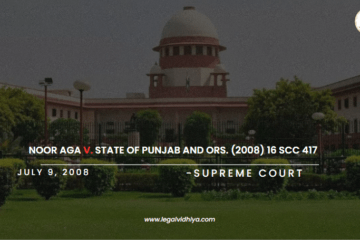
| CITATION | AIR 1965 SC 1564 |
| DATE OF JUDGEMENT | 01-02-1965 |
| COURT | SUPREME COURT |
| APPELLANT | BHAURAO SHANKAR LOKHANDE |
| RESPONDENT | STATE OF MAHARASHTRA |
| BENCH | DAYAL, RAGHUBAR; MUDHOLKAR, J.R; RAMASWAMI, V. |
INTRODUCTION-
In the case of Bhaurao Shankar Lokhande v. State of Maharashtra, a special leave appeal was brought against the Bombay High Court’s decision and order rendered in Criminal Revision Application No. 388 of 1963 on August 19, 1963. The court’s contested decision finding the appellant guilty of the violation of Section 494 was reversed, and an order of acquittal was subsequently issued.
FACTS OF THE CASE-
- In 1956, Bhaurao Shankar Lokhande, the appellant, got married to Indubai, the complainant.
- They were married in accordance with religious rites and traditions. In February 1962, he married another woman, Kamlabai, during this period.
- Deorao Shankar Lokhande, the second appellant, was the brother of Bhaurao Shankar Lokhande, the first appellant.
- The two appellants were tried for an offense under Section 494 of the I.P.C. alongside Kamlabai, her father, and a barber. However, the Magistrate acquitted the latter three. While Appellant No. 2 was sentenced for an offense under Section 494 of the I.P.C. read with Section 114 of the I.P.C. (abetment of the offence), Appellant No. 1 was found guilty under Section 494 of the I.P.C.
- The Sessions Court denied the Appellants’ request for review. Their High Court revision petition was also denied. They ultimately decided that a special leave appeal to the Supreme Court was preferable.
ISSUES RAISED-
- Whether or not the appellant’s second marriage was valid.
- Is the appellant guilty of violating Section 494 of the IPC?
SECTIONS REFERRED IN THIS CASE-
- Section 494 (Bigamy): The statute reads: “Whoever, having a husband or wife living, marries in any case in which such marriage is void by reason of its taking place during the life of such husband or wife, shall be punished with imprisonment of either description for a term which may extend to seven years, and shall also be liable to fine.”
- Section 114 of the Indian penal code states that “whenever any person who, if absent, would be liable to be punished as an abettor, is present when the act or offence for which he would be punishable in consequence of the abetment is committed, he shall be deemed to have committed such act or offence.”
- Section 7 of the HMA of 1955– According to Section 7 of the Act, a Hindu marriage may be solemnized in accordance with the customary rites and ceremonies of either -party.
- Section 17 of the HMA of 1955- Punishment for Bigamy: “Any marriage between two Hindus solemnized after the commencement of this Act is void if at the time of such marriage either party had a husband or wife living; and the provisions of sections 494 and 495 of the Indian Penal Code (45 of 1860), shall apply accordingly.”
ARGUMENTS MADE BY THE PARTIES:
By the Appellant:
- The prosecution must establish in law that the alleged second marriage of Appellant no.1 with Kamlabai in 1962 was performed in accordance with the religious rites applicable to the type of marriage undergone.
- When Appellant no.1 and Kamlabai married, essential ceremonies and practices for a valid marriage were not performed.
By the Respondent:
- The marriage proceedings between Appellant No.1 and Kamlabai followed the customs of the appellants’ community for the Gandharva form of marriage.
- The marriage of Appellant No. 1 and Kamlabai was legal.
- It is not necessary for the second to be a valid marriage under the law in order to commit the offence under Section 494 of the I.P.C. A person who engages in any form of marriage during the lifetime of his or her spouse from a previous marriage commits the Section 494 offense.
OBITER DICTA:
- In Section 494 of the I.P.C., the phrase ‘whoever……marries’ must mean ‘whoever marries validly’ or ‘whoever marries and whose marriage is valid’.
- A marriage will be considered ‘ solemnized’ if it is ‘celebrated and performed with proper ceremonies and due form.’
- The two most important ceremonies in a Gandharva wedding are (1) invocation before the sacred fire and (2) the bride and groom taking seven steps together in front of the sacred fire (Saptapadi).
- There was also no evidence that the Appellant’s community’s customs permitted an annulment of these two important Gandharva marriage ceremonies.
JUDGEMENT (DECISION) -:
- The prosecution has failed to prove that appellant no. 1 and Kamlabai’s marriage in February 1962 was conducted in accordance with the customary rites as required by section 7 of the Act. As a result, the marriage of appellant no. 1 and Kamlabai does not fall under the definition of “solemnized marriage” found in Section 17 of the Act, and as a result, does not violate Section 494 I.P.C.
- As a result, the convictions of appellant No. 1 under Section 494 of the IPC and appellant No. 2 under Section 494 read with Section 114 of the IPC cannot be upheld. As a result, their convictions were overturned and they were exonerated after the appeal was accepted.
CONCLUSION:
Even if a man and a woman portray themselves as husband and wife and society treats them as husband and wife, simply living together as husband and wife does not confer the status of husband and wife. For a marriage to be valid, the necessary and mandatory ceremonies according to religious beliefs and community practices must be performed.
REFERENCES-
This Article is written by Aastha Srivastava, a 3rd Year LL.B student of DES Shri Navalmal Firodia Law College, Pune; Intern at Legal Vidhiya.




0 Comments